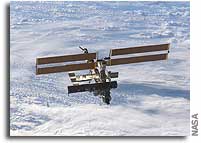ISS On-Orbit Status 26 Jan 2003

Second weekend off-duty day for the crew. All ISS systems continue to function nominally, except as noted previously or below.
The crew’s current Renal (kidney) Stone research program continued. [The regimen of urine collection came to an end for FE-2/SO Don Pettit. CDR Bowersox’s second day required him to collect samples during the day besides diet logging. FE-1 Nikolai Budarin began his part in the experiment with his dietary intake log.]
Budarin conducted the daily checkup, with watering if necessary, of the BIO-5 Rasteniya-2/Lada-2 (“Plants-2”) plant growth payload.
Budarin also performed the weekly routine tasks of collecting SP toilet flush counter and SVO water supply readings for calldown, as well as the periodic check-out of the Elektron oxygen generator’s VM gas/liquid system for the air bubble that usually lingers after an in-flight maintenance (IFM).
Pettit completed the daily routine maintenance of the SOSh life support system, incl. ASU toilet subsystem, and prepared the IMS inventory database for automated file import/export.
The Russian task-listed Uragan (“hurricane”) earth imaging program, using the Rubinar binocular telescope and the Nikon D1 digital camera with f400-mm lens, yesterday and today targeted the Kerguelen Island, Bouvet Island, South Georgia Island and glaciers of the Patagonia North and South ice floes.
All crewmembers had their weekly PFCs (private family conferences), via TV downlink.
The installation of the new window in the Node starboard hatch (toward the Airlock), replacing the mounting plate of the old ECOMM (early comm) antenna, was on the U.S. task list for today and tomorrow. [Bowersox was advised to use lint-free gloves for handling the hardware, and to provide a 30-min. advance notice to MCC-H before beginning the R&R. Instead of today, the procedure would be delayed to early tomorrow morning if the first two hours of post-R&R pressure measurements fall in the crew sleep period.]
The S1 radiator clearance check with the SSRMS video camera, set up on 1/23, is scheduled for tomorrow, in LVLH attitude. [The clearance between the deployed S1 radiator panel and the P6 starboard radiator has been analytically determined to be as little as +1.46 inches at the point of closest approach between the two radiators during the 12A.1 ops. Thus being in the critical path for 12A.1, the clearance check is to validate the analysis and alleviate the constraints placed on TRRJ (thermal radiator rotary joint) rotation.]
Yesterday, the ground commanded both BGAs (beta gimbal assemblies) of the P6 photovoltaic power module’s 2B and 4B arrays to directed position (Blind) mode for dual-rate angle ops. The procedure was executed over several hours via pre-stored time-tag commands.
Today’s targets for the CEO (crew earth observations) program, benefiting from the current increase in daylight in the land hemisphere, were Dar es Salaam, Tanzania (pass over this port city. Looking a touch right; ESC [electronic still camera]), Patagonian Glaciers (glacier tongues in the Northern Icefield should have been clear. Detailed nadir views were requested), Buenos Aires, Argentina (nadir pass; ESC), Landslide site, Chile (detailed views at nadir in a mapping strip will intersect a high Andean landslide site under study. A mapping strip of wider views off nadir is of great interest for a study aimed at understanding the age of the Atacama Desert [based on landform history, best studied by remote means]), SE Australia smoke pall (fires and widespread blankets of smoke have been making the news. Today the smoke pall in tinder-dry SE Australia extends out sea and hooks westwards into the strait between Tasmania and the mainland. Looking mainly right of track. Low sun angles are helpful for aerosol documentation), and Caracas, Venezuela (nadir pass; ESC).
CEO images can be viewed at the website
http://eol.jsc.nasa.gov
ISS Orbit (as of this morning, 7:37am EST [= epoch]):
- Mean altitude — 388.3 km
- Apogee — 392.2 km
- Perigee — 384.5 km
- Period — 92.32 min.
- Inclination (to Equator) — 51.64 deg
- Eccentricity — 0.0005662
- Orbits per 24-hr. day — 15.60
- Altitude loss — 150 m (mean) in last 24 hours
- Revolutions since FGB/Zarya launch (Nov. ’98) — 23890
- For more on ISS orbit and worldwide naked-eye visibility dates/times, see
- http://www.hq.nasa.gov/osf/station/viewing/issvis.html








